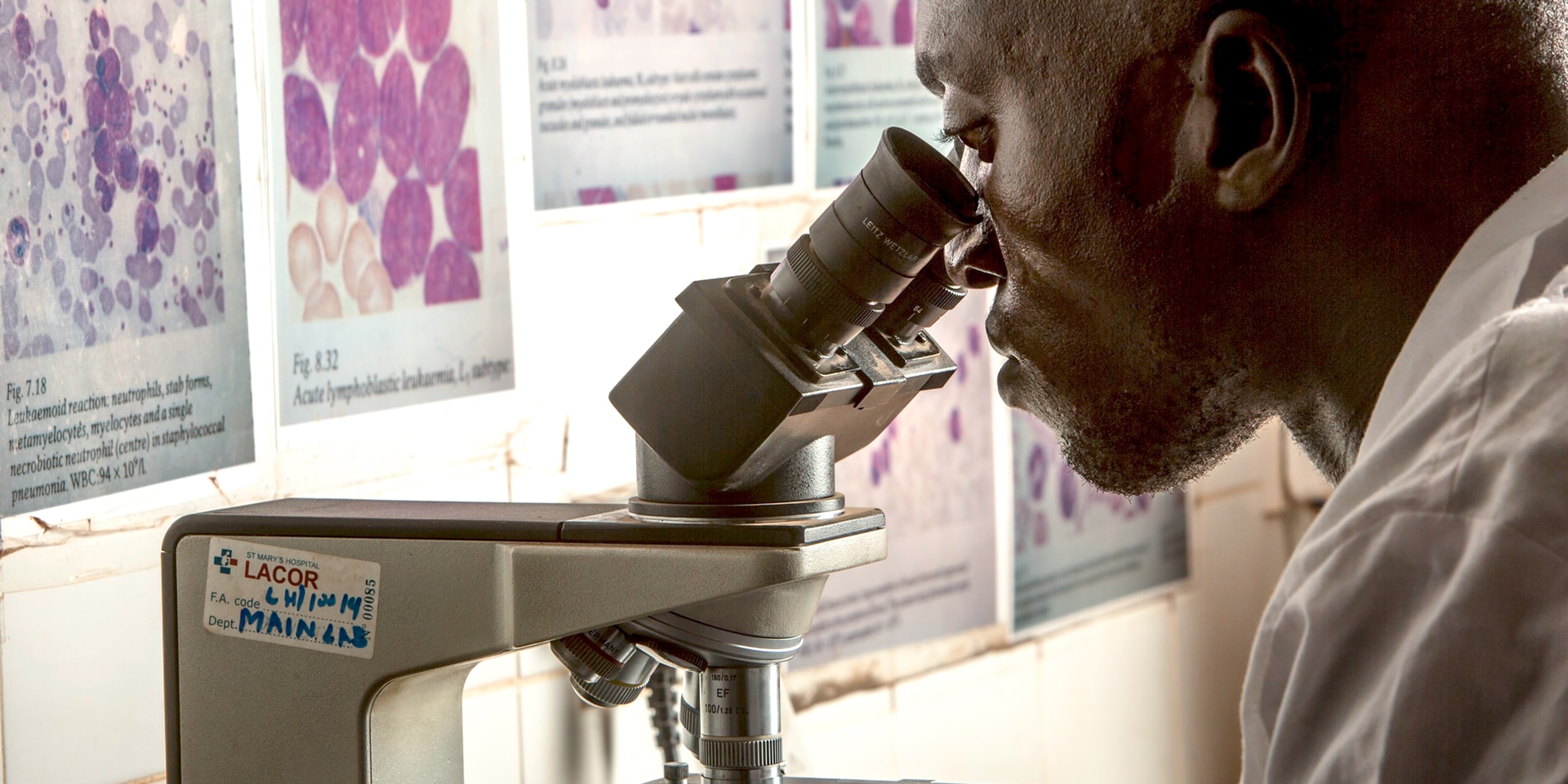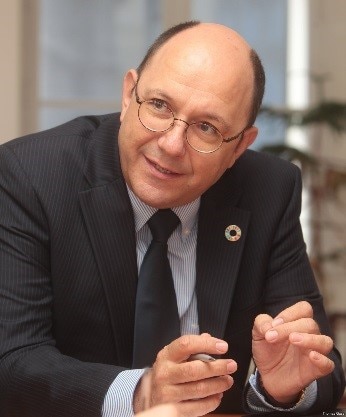SDC strengthens cooperation with the private sector in poverty reduction
The Swiss Agency for Development and Cooperation (SDC) has poverty reduction and sustainable development as its primary goal. To achieve this, it relies on innovative solutions and new partnerships. Especially in fragile contexts where there is great poverty, unconventional approaches and new instruments are often needed, says SDC Deputy Director-General Thomas Gass. In some cases, these can only be implemented in cooperation with private sector actors.

An employee of St. Mary's Hospital in Uganda is examining a blood sample for malaria pathogens. © Keystone

Thomas Gass © FDFA
Ambassador Thomas Gass has been Deputy Director-General and Head of the Cooperation with the South Division of the Swiss Agency for Development and Cooperation (SDC) within the Federal Department of Foreign Affairs (FDFA) since 1 January 2018. Previously, Thomas Gass was, among other things, Assistant Secretary-General in the Economic and Social Affairs Division of the United Nations Secretariat in New York and Head of the Swiss Mission in Nepal.
The SDC's Southern Cooperation Division finances development projects in priority countries and regions in Africa, Asia, Latin America and the Caribbean.
“It is important to use the specific strengths”
Mr. Gass, Switzerland's international cooperation (IC) is increasingly carried out in partnership with the private sector in order to achieve sustainable development objectives. What specific goals does the SDC aim to achieve through these partnerships?
Partnerships with the private sector on specific projects make it possible to mobilise private resources for the development of innovative solutions – in line with socially and environmentally compatible standards. This leads to new products, services, technological developments and innovative business and financing models that benefit poor and marginalised population groups. These joint efforts will continue to aim to accomplish sustainable development and poverty reduction goals.
Switzerland supports the UN's 2030 Agenda for Sustainable Development and its 17 Sustainable Development Goals (SDGs). The SDGs can only be achieved if in addition to official development assistance (ODA) and the allocation of national tax revenues, the private sector can also be mobilised to contribute to more sustainable global development. The SDC therefore intends to further expand its long-standing engagement with the private sector in order to achieve the global development and climate protection goals and implement the new Dispatch on Switzerland's Strategy for International Cooperation 2021–24.
The 2030 Agenda for Sustainable Development is also based on public-private partnerships and has set a specific development goal to this end (SDG 17). Does this mean that Switzerland's international cooperation and the 2030 Agenda are pursuing mutually compatible goals?
The answer is a clear yes. SDG 17 explicitly states that inclusive partnerships are needed to achieve the 2030 Agenda. This means that all actors involved in development activities should pool their strengths and resources. This applies equally to states, civil society organisations, research institutes, foundations and the private sector.
The goal of a socially and environmentally compatible economy set out in the 2030 Agenda requires a far-reaching transformation of economic systems, for example with regard to working conditions that are fair and in compliance with human rights obligations (SDG 8), the effective and sustainable use of resources (SDG 7 and SDG 13, among others) and sustainable consumption and production patterns (SDG 12). The general public is now demanding that private companies play their part in bringing about this change and act responsibly. The enormous resources and innovative capacity of private companies are increasingly seen as an opportunity to involve a diverse range of private sector players in solving the global challenges of our time.
In addition to SDG 17, the SDC's engagement with the private sector is also based on the Financing for Development Agenda, especially the 2015 Addis Ababa Action Agenda. This global framework underscores the need to mobilise the resources of national and international companies in line with the SDGs.
Switzerland has long-standing international cooperation partnerships with the private sector. The aim is to strengthen them even further. What has been the SDC's experience with the private sector to date?
The SDC began to establish private-public development partnerships in the 1990s. An early and very successful example was our cooperation with the Geneva-based Medicines for Malaria Venture (MMV). Thanks to the pioneering role played by Swiss medical science in the fight against malaria, MMV, with the support of the SDC and in close cooperation with partner countries in the Global South, has been able to advance research into and development of new anti-malarial medicines and to make them available at low cost to affected populations.
The SDC sees growing private sector interest in public-private partnerships to tackle development challenges. There is a clear trend towards greater sustainability both in the real economy and in the financial sector. Companies that recognise growing public awareness of the importance of socially and environmentally responsible business practices as an opportunity are particularly promising partners for the SDC.
At the end of 2019, the SDC had a portfolio of about 75 ongoing partnerships with the private sector. Approximately 30% of these partnerships involve economic development and employment projects and a further 20% are health sector projects.
How do these partnerships work specifically? Could you give two examples?
The SDC works with various categories of private sector partners: large companies and multinationals, small and medium-sized enterprises, social enterprises, impact investors and foundations. Each category has specific strengths that need to be leveraged. Although NGOs, research centres and academic institutions are strictly speaking not part of the private sector, they are often involved in such projects because of their specific expertise, for example as implementation partners.
The SDC works with various categories of private sector partners: large corporations and multinationals, small and medium-sized enterprises, social enterprises, impact investors and promotional foundations. Each category has specific strengths that must be exploited.
Together with research institutes, civil society actors and foundations, the SDC supports various initiatives to combat a variety of diseases worldwide. The SDC also supports financial institutions in various countries in Africa and Asia that offer microcredit and insurance to specific groups such as smallholder farmers and migrant women. Such projects allow poor and marginalised groups to receive essential services tailored to their needs.
There have also been critical voices concerning the involvement of the private sector, arguing that it runs counter to the actual goal of development cooperation, which is poverty reduction. What's your response to this criticism?
The SDC is increasingly working in fragile contexts beset by severe poverty. This often calls for unconventional approaches and new mechanisms, which can in some cases only be implemented in cooperation with private sector actors. Moreover, partnerships with the private sector allow us to mobilise additional funding and expertise, increasing the availability of resources for poverty reduction efforts and sustainable development. This helps in the fight against poverty.
It is important to stress that cooperation with the private sector is only one of many approaches used by the SDC. What's more, partnerships with the private sector are but a means to an end: If an approach adopted for a specific project turns out to be incompatible with the primary objectives of reducing poverty and promoting sustainable development – and thus with the SDC's mandate – it is replaced by one that does meet these requirements. And the effective and targeted involvement of the private sector in international cooperation is predicated on a broad consensus among the donor community and based on international agreements and declarations.
